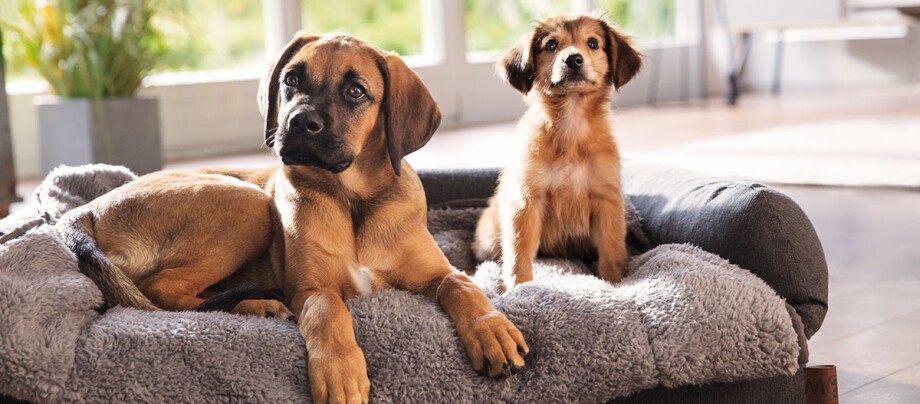Get All the Information You Need on Owning Several Dogs – Lead Dogs Together
07.10.2022 - Reading time: 7 minutes

So you simply can’t get enough of dogs and you’ve already asked yourself whether it might not be really nice to have a second dog. But before you introduce this second animal into your home, you should consider a few things. Looking after more than one dog is a challenge and certainly won’t resolve any problems that you might already have with your dog. Find out here how to make the right decision and how to prepare yourself properly to look after at least two four-legged friends!
Important prerequisites for managing a pack
However enticing the idea of more than one dog might be for dog lovers, it’s not just your fun with your four-legged friend that increases with more than one dog. Therefore, before you gaily introduce a second dog into your home, you should first clarify the financial, space and time aspects.
All increase with a second dog:
- Costs for food, vet, equipment, dog tax and liability insurance
- Time required for grooming and dog training, as well as possibly separate training
- Knowledge required for managing a pack
- Space required in your apartment and car
- Restrictions in holiday planning, expensive dog kennels
In addition, you should consider the following points:
- First of all clarify some of the most common misconceptions about having more than one dog: dogs in a pack don’t simply entertain each other! Their master/mistress remains their most important point of reference.
- Consider whether you could share the tasks of looking after more than one dog with someone, or whether you would have to do everything yourself. Do you have enough energy and time resources for that?
- Try to approach the decision regarding the pros and cons of a second dog as rationally as possible, and also consider what is best for your first dog. Is your dog a loner who is very attached to you? If yes, then a second dog could be a problem for him.
Owning more than one dog: Which dogs get on well together?
Not all dogs get on well together, even though dogs are basically pack animals and very sociable. Whether you decide on a male or a female, an older dog or a puppy, should be decided by what your first dog would like.
Some food for thought:
The gender of the dogs plays a major role in how the pair of them get along together – and of course, yours too. As a rule, a male dog and a female dog will settle down with each other more easily. If they have not been neutered, you will have to keep them apart when the female dog is on heat, unless you want a litter. That can become quite stressful on a daily basis. When the female dog is on heat or suffering a false pregnancy her behaviour can sometimes be quite tricky. Two female dogs together could become fierce rivals. A walk with a male dog and a female dog on heat must be very well controlled in order to avoid aggressive behaviour from other dogs. This is also true if you are walking with two female dogs on heat.
A young puppy can give an older dog a new lease of life, or it can enormously overtax the older dog whilst it remains under-stimulated itself. In just the same way as a disabled dog can orientate itself around a healthy dog, a fit and healthy second dog can permanently stress an older or disabled dog.
Good to know: Dog experts recommend an optimum age difference of around a maximum of three years, so that the dogs do not hinder each other or negatively influence each other in their development phases. However, it must be borne in mind that small dogs mature more quickly but age more slowly than very large dogs. The actual age of the dog itself is therefore only a rough guide. The individual nature of the dogs concerned is a much better indicator of whether they will get on together.
Extreme differences in size and breed can result in the larger dog not accepting the smaller one as a dog at all or even (inadvertently) injuring it. A gentle character will not cope well with a turbulent dog, although in contrast, a dominant dog and an anxious dog can make good partners.
Three rules for a dog pack
When keeping more than one dog, obedience training becomes even more important. Whatever happens, a new dog should not be introduced on an ad hoc basis. Earmark some time, ideally a holiday, to introduce your new dog to your previously single dog, since you need time to make the necessary purchases and you also need to feel relaxed in order to get to grips with your growing pack.
Rule no. 1: Love is through the nose and stops at food
Dogs decide on friend and enemy by scent. Therefore bring a blanket or toy belonging to the new dog into your home and give the new dog something to sniff as well. This way, the dogs can familiarise themselves with each other by scent in advance. Make sure they have separate beds and that their respective food and water bowls are well distanced from each other.
Rule no. 2: Familiarisation on neutral territory
The dogs should meet for the first time on neutral territory – ideally a fenced-off area that is free of distractions. You need a helper with you for the first time they meet, who is in charge of the new dog. Well socialised and obedient dogs can be let off the leash. In the case of doubt, use a drag leash for each, so that you can grab hold of them if necessary. Take them for a walk until their excitement has completely calmed down.
Before the new dog enters your home you must remove all food remains and toys so that no ownership hierarchy is established on the first visit. When entering your home you lead the way with your new four-legged friend, whilst your helper waits with your original dog. Give the new dog time to thoroughly explore his new home and then ask your helper to join you with your original dog.
Be patient: Sometimes it can take more than two weeks before the dogs settle down and can be left alone without supervision.
Rule no. 3: Establish the hierarchy
Do not be led astray by the idea that “the dogs will sort it out between them”, because it’s not the dominant dog who has the last word, but you, as the leader of the pack.
Observe precisely how the hierarchy develops between your dogs. Only accept the dominant position of a dog if the pack as a whole is comfortable with this. Let your dogs know what you find unacceptable and create a relaxed atmosphere by setting clear rules that apply to all, with no exceptions. As a rule, only minor corrections are required. For example, if one dog wants to play and is annoying another dog that wants to sleep, take on the role of the playfellow for a while, or make sure that the active dog leaves the other dog in peace. Separate beds – in different rooms if necessary – are a good preventive measure, as each dog can be sent to its separate bed.
Rule no. 4: Prevent jealousy
In order to avoid jealousy in your dog pack, you must spend equal time with both dogs – both individually and together. Find the time and a quiet place to reassure your first dog that you will always be there for him. What do your dogs love? The one loves playing frisbee, the other is ace at tracking? Then give each a turn to show off. Also: find something that both dogs really enjoy as that will bond them together!
When your pack expands
If you want to own more than two dogs, repeat these steps. It is now important that your existing pack accepts the newcomer, which can sometimes be difficult, but doesn’t need to be. If you are uncertain, consult an experienced dog trainer who will be able to assess the situation and offer you support.
Owning multiple dogs: Further reading
Make sure you get all the information you need. There are numerous books and seminars on owning multiple dogs. And if you’ve still got a problem – get some professional support! The fewer the negative behaviours that are allowed to creep in, the easier it is to eradicate them.


